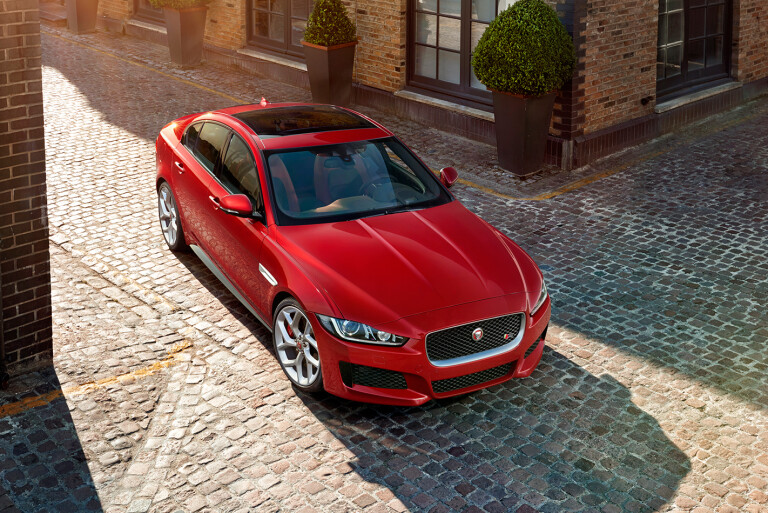
JAGUAR’S new XE, revealed last night in London, is a cleverly seductive car that needs to succeed.
This low and lovely compact rear-drive sedan – styled by long-time Jaguar design chief Ian Callum – should be every bit as satisfying to use as it is to look at, and must be in order to compete with the BMW 3 Series, Mercedes C-Class and Audi A4.
“We set out to deliver the best drivers car in the segment,” chief program engineer Nick Miller told journalists ahead of the XE’s reveal.
It will be the first Jaguar into production using an all-new and lightweight aluminium-intensive platform with promisingly sophisticated suspension and steering.
The XE also introduces Jaguar’s new, designed-from-scratch Ingenium family of modular engines. Including the new factory to manufacture these engines, around £1.5 billion ($A2.6bn) has been spent by Jaguar to bring the XE to market.
To repay this massive investment, the XE – and the other models that will use the same platform – must deliver a large boost in Jaguar’s global sales volume. Exactly how big, no-one will say, but the consequences of marketplace failure would obviously endanger Jaguar’s health.
On sale from May next year, the XE will compete against the big-selling Germans and Jaguar promises starting prices in Europe will be similar to those of the equivalent BMW and Mercedes-Benz models.
There’s no reason why the same should not apply in Australia, where the XE will arrive months later, in August.
Here are the highlights from a series of technical briefings delivered in the lead-up to the XE’s big-budget Earls Court reveal.
Drivetrains
FIRST of Jaguar’s clean-sheet-design Ingenium family of turbocharged modular engines into production will be a 2.0-litre diesel.
This engine is aimed straight at the heart of Europe, where fuel is expensive and high emitters are taxed. Jaguar promises 3.8L/100km consumption and 99g/km CO2 emissions.
The turbo-diesel is just the first instalment of the series. Jaguar engine engineering chief Paul Whitwood promises new variants will appear every three to six months for the next three years, all of them built around a basic 500cc cylinder module.
A turbocharged 2.0-litre petrol four will be next, Jaguar confirms. What comes next is less clear.
A three-cylinder version of Ingenium is a certainty for future hybrid models, though whether petrol, diesel or both isn’t clear.
At the opposite end of the spectrum, Whitwood says an in-line six-cylinder version of Ingenium makes more sense than a V6. So Jaguar could produce a rival for BMW’s excellent in-line 3.0-litre turbo six.
The final possibility is a turbocharged 4.0-litre V8, which would be a more efficient replacement for Jaguar-Land Rover’s naturally aspirated and supercharged 5.0-litre V8s.
Such developments are some way off.
The model unveiled in London was the XE S, which will use the same 250kW/450Nm supercharged V6 as the F-Type.
The XE S will have the same eight-speed ZF-made automatic as the F-Type, but a lighter version will be used in the four-cylinder cars.
A six-speed ZF manual, the first non-auto Jaguar for six years, will be offered with the 2.0-litre turbo diesel engine.
Jaguar engineers confirm the XE’s platform is able to accommodate all-wheel drive. It’s a necessity, as the architecture will also serve as the basis for the company’s sporty SUV, due in 2016.
Body
JAGUAR describes the XE’s platform as aluminium-intensive. Some 75 percent of the sedan’s body is made from aluminium, including alloys that can be made mainly from recycled metal.
A weight advantage is promised, compared to its steely competition. The weight of the lightest XE will be 1474kg.
The doors, bootlid and rear of the XE’s floorpan are all made from steel, chiefly to endow the car with 50/50 weight distribution, according to program chief Nick Miller.
The use of steel doors and bootlid also facilitates future weight cuts, as these are easily replaced with aluminium components.
Chassis
THE multi-link coil-spring rear suspension of the XE is more sophisticated than the class average. In fact, it’s the kind of design usually found only in cars one or two classes above, claims Nick Miller.
A primary design objective was to deliver both supple ride and sharp handling, along with a useful cargo compartment.
Only driving will show whether Jaguar’s dynamic objectives have been achieved, but the XE’s 455-litre boot capacity is impressive.
Up front, the XE has a double A-arm suspension, again with coil springs. No air suspension is planned, but Jaguar will offer passive and active damping systems.
The XE is the first Jaguar to adopt electric steering assistance. It’s needed to support safety and convenience features such as lane-keeping assist and self-parking, but vehicle engineering manager Jon Darlington promises superb feel and precision will also be delivered.
Will it work?
OUR first close-up look at the first in Jaguar’s new generation is hugely impressive.
The company’s engineers and designers seem to have seized their opportunity to show the world how good they are.
The XE is a car we can hardly wait to drive…

COMMENTS